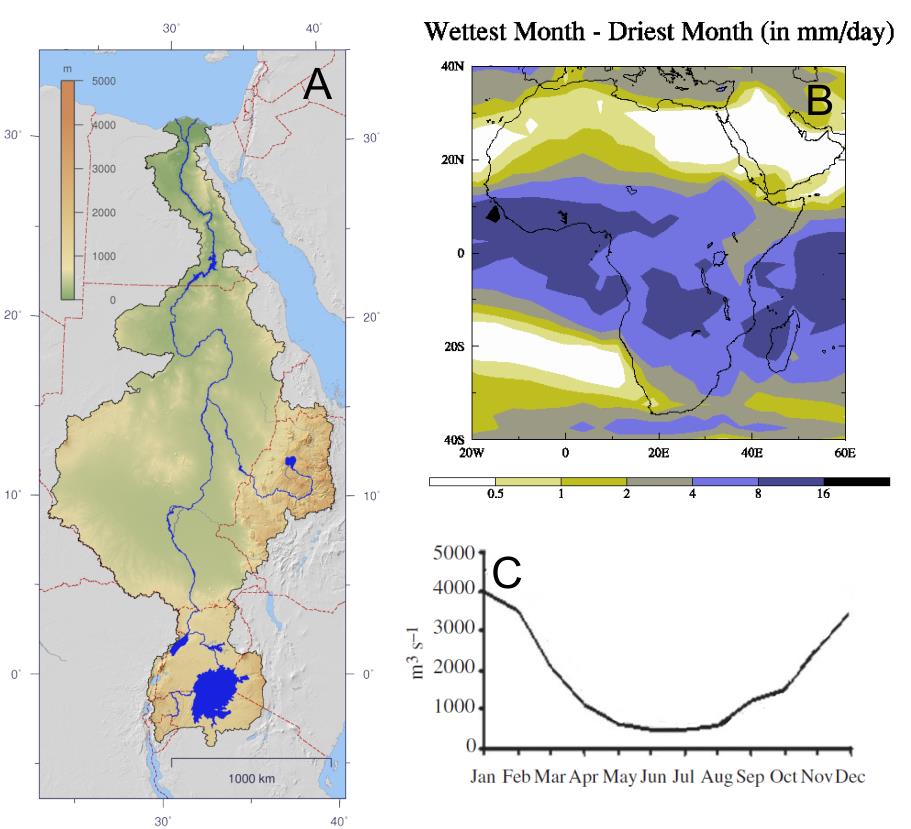Ancient Egyptians and climate change
The Egyptian civilization developed in the arid climates of North Africa by utilising the hydrological resources of the River Nile. However, this makes the population of Ancient Egypt vulnerable to the changing patterns of climate. The archaeological record shows significant fluctuations in the population of ancient Egypt, which have been related to changes in the flow of the River Nile throughout the ancient period (Bernhardt et al., 2012; Macklin and Lewin, 2015). Whether these changes in flow are forced by climate changes or natural variability and what aspects of climate the population are responding to remains unknown. The river undergoes huge annual fluctuations in flow, driven by monsoonal rainfalls in the Nile source regions, which enable the irrigation and cultivation of the Nile valley. The African monsoons are known to have varied greatly during the Holocene (last 10,000 years), enabling the greening of the Sahara and human occupation of North Africa (Shanahan et al., 2015).
This project will examine a new suite of snapshot climate model simulations, with varying orbital forcing and greenhouse gases, covering the period from 5000-0 BC. The climate and river flows from these simulations will be compared to proxy records through this period and the climatic drivers of these hydrological changes determined. Then these fluctuations will be correlated to changes in the population of the Nile river valley and the well-established hypothesis of hydrological driven demographic change in ancient Egypt (Butzer, 1976) can be tested within a climate modelling framework for the first time.
The initial climate model simulations for this project will already have been run, but the student will be responsible for analysing these. They will also have to collate the available palaeoenvironmental data from the Nile and surrounding regions and evaluate the spatial and temporal patterns of the simulations against these. The project will be hosted within the Palaeo@Leeds, a world-class multi-disciplinary research group that explores Earth history in many different ways. The student would be expected to fully participate in the research group and present project results in a science meeting. The project will require many transferable skills to be learnt, including handling and processing large data sets, analysing and visualising climate phenomena, collaborating with a diverse group of scientists and working within a supercomputing architecture.

Figure 1. (A) The Nile River basin, (B) modelled pre-industrial seasonality of rainfall over Africa and (C) simulated present-day Nile River flow (Jin et al., 2010).
References:
- Bernhardt, C.E., Horton, B.P. and Stanley, J-D., 2012. Nile delta vegetation response to Holocene climate variability. Geology, 40, 615-618.
- Butzer, K.W., 1976. Early hydraulic civilization in Egypt. Prehistoric Archeology and Ecology, University of Chicago Press.
- Jin, F., Kitoh, A. and Alpert, P., 2010. Water cycle changes over the Mediterranean: a comparison study of a super-high-resolution global model with CMIP3. Phil. Trans. R. Soc. A, 368, 5137-5149.
- Macklin, M.G. and Lewin, J., 2015. The rivers of civilization. Quaternary Science Reviews, 114, 228-244.
- Shanahan, T.M. et al., 2015. The time-transgressive termination of the African Humid Period. Nature Geoscience, 8, 140-144.















